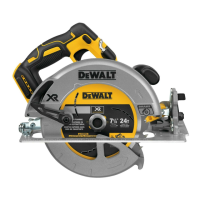8
ENGLISH
b ) When blade is binding, or when interrupting a cut
for any reason, release the trigger and hold the saw
motionless in the material until the blade comes to
a complete stop. Never attempt to remove the saw
from the work or pull the saw backward while the
blade is in motion or kickback may occur. Investigate
and take corrective actions to eliminate the cause of
bladebinding.
c ) When restarting a saw in the workpiece, centre
the saw blade in the kerf so that the saw teeth are
not engaged into the material. If saw blade binds, it
may walk up or kickback from the workpiece as the saw
isrestarted.
d ) Support large panels to minimise the risk of blade
pinching and kickback. Large panels tend to sag
under their own weight. Supports must be placed under
the panel on both sides, near the line of cut and near the
edge of thepanel.
e ) Do not use dull or damaged blades. Unsharpened
or improperly set blades produce narrow kerf causing
excessive friction, blade binding andkickback.
f ) Blade depth and bevel adjusting locking levers
must be tight and secure before making cut. If blade
adjustment shifts while cutting, it may cause binding
andkickback.
g ) Use extra caution when sawing into existing walls or
other blind areas. The protruding blade may cut objects
that can causekickback.
SAFETY INSTRUCTIONS FOR SAWS WITH A
PENDULUM BLADE GUARD
Lower Guard Function
a ) Check the lower guard for proper closing before each
use. Do not operate the saw if the lower guard does
not move freely and close instantly. Never clamp
or tie the lower guard into the open position. If the
saw is accidentally dropped, the lower guard may
be bent. Raise the lower guard with the retracting handle
and make sure it moves freely and does not touch the
blade or any other part, in all angles and depths ofcut.
b ) Check the operation of the lower guard spring. If the
guard and the spring are not operating properly,
they must be serviced before use. Lower guard may
operate sluggishly due to damaged parts, gummy
deposits, or a build-up ofdebris.
c ) The lower guard should be retracted manually
only for special cuts such as “plunge cuts” and
“compound cuts”. Raise the lower guard by
retracting handle and as soon as blade enters
the material, the lower guard must be released.
For all other sawing, the lower guard should
operateautomatically.
d ) Always observe that the lower guard is covering
the blade before placing the saw down on bench or
floor. An unprotected, coasting blade will cause the
saw to walk backwards, cutting whatever is in its
path. Be aware of the time it takes for the blade to stop
after switch isreleased.
Additional Safety Instructions for Circular
Saws
• Wear ear protectors. Exposure to noise can cause
hearingloss.
• Wear a dust mask. Exposure to dust particles can cause
breathing difficulty and possibleinjury.
• Do not use blades of larger or smaller diameter than
recommended. For the proper blade rating refer to the
Technical Data. Use only the blades specified in this manual,
complying with EN 847-1.
• Never use abrasive cut-offwheels.
• Do not use water feedattachments.
• Use clamps or another practical way to secure and
support the workpiece to a stable platform. Holding the
work by hand or against your body leaves it unstable and may
lead to loss ofcontrol.
Residual Risks
In spite of the application of the relevant safety regulations
and the implementation of safety devices, certain residual risks
cannot be avoided. These are:
• Impairment ofhearing.
• Risk of personal injury due to flyingparticles.
• Risk of burns due to accessories becoming hot
duringoperation.
• Risk of personal injury due to prolongeduse.
Electrical Safety
The electric motor has been designed for one voltage only.
Always check that the battery pack voltage corresponds to the
voltage on the rating plate. Also make sure that the voltage of
your charger corresponds to that of yourmains.
Your

